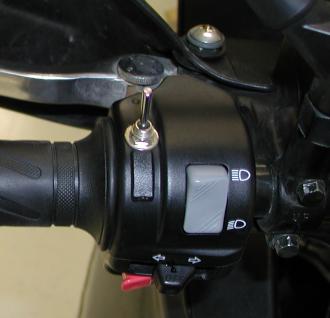 I decided to add a three-way toggle switch
to the left handlebar controls, as seen at right (in the photo the
switch is in the middle position). The three positions are:
I decided to add a three-way toggle switch
to the left handlebar controls, as seen at right (in the photo the
switch is in the middle position). The three positions are:  I decided to add a three-way toggle switch
to the left handlebar controls, as seen at right (in the photo the
switch is in the middle position). The three positions are:
I decided to add a three-way toggle switch
to the left handlebar controls, as seen at right (in the photo the
switch is in the middle position). The three positions are:
I thought about adding a OFF position (non-US bikes already have this), but four-position toggle switches are rather hard to come by, and I didn't want to add another switch. Plus, I don't see all that much need to turn the headlights off.
All of this headlight trickery works by switching relays on and off
on a relay board I added to control the lights. This means that my
switch doesn't have to handle high current, and also avoids the
resistance problem described above.
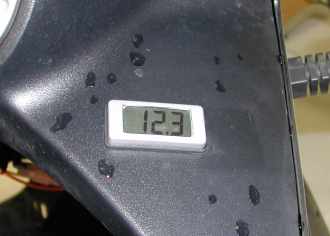 In order to monitor the state of the
charging system, I added a digital voltmeter, as seen to the right.
With the bike off, it reads about 12.1 - 12.5 volts, depending on
the state of the battery. With the bike running, above 12.5 volts
means the battery is charging, below 12.5 means the battery is
discharging. The charging system will bring the voltage up to 14.0
volts, if it can.
In order to monitor the state of the
charging system, I added a digital voltmeter, as seen to the right.
With the bike off, it reads about 12.1 - 12.5 volts, depending on
the state of the battery. With the bike running, above 12.5 volts
means the battery is charging, below 12.5 means the battery is
discharging. The charging system will bring the voltage up to 14.0
volts, if it can.
With both low beams on, the voltmeter reads about 13.5 volts at idle, and 14.0 volts at anything higher than idle. With my Gerbing heated jacket and gloves turned on full (the jacket should draw 77 watts and the gloves 22 watts, for a total draw of 99 watts) and both low beams on the voltmeter reads about 12.5 volts - just breaking even; with just one low beam turned on, the voltmeter reads about 13.5 volts - healthy; with both low and high beams on, the voltmeter reads 11.5 volts - beware.
Here are images of the top and bottom of the relay board:
The board is a little proto-board from Radio Shack, measuring about
1.75" x 1.75". I don't know if Radio Shack still sells them; I
found it in a pile of junk at work. The relays are made by Potter
& Brumfield, model # T77S1D10-12. They are speced
at 10A @ 30VDC with 100,000 cycles, so they should last a good long
time. There are two diodes (nestled between the two rightmost
relays in the left image above) which make the SQUINT mode work.
When I get a chance, I will add a schematic and part list here.
The voltmeter is made by Martel Electronics, part # QM100V. It cost $44 from Digi-Key. It's nice for this application because it's water resistant, requires a single 1/4" hole to mount, and only requires two wires hooked up (power and ground) - many other panel-mount voltmeters require +5V in addition to the voltage to be measured.
 I used standard automotive insulated
blade connectors to splice into the wiring for each headlight - the
relay board intercepts each headlight wire, uses it to drive a relay,
and the output of the relay drives the headlight. One nice thing
about using male and female blade connectors is that if the board dies
or a future owner wants to remove it, one can just reconnect the blade
connectors to bypass the relay board. To the right is an image of
connectors for one headlight.
I used standard automotive insulated
blade connectors to splice into the wiring for each headlight - the
relay board intercepts each headlight wire, uses it to drive a relay,
and the output of the relay drives the headlight. One nice thing
about using male and female blade connectors is that if the board dies
or a future owner wants to remove it, one can just reconnect the blade
connectors to bypass the relay board. To the right is an image of
connectors for one headlight.
 The relay board gets power by a separate
fused wire that runs direct from the battery, for minimal voltage drop.
In the image to the right, it's the wire with the yellow fuse
holder. The other stuff supplies power to other accessories.
The relay board gets power by a separate
fused wire that runs direct from the battery, for minimal voltage drop.
In the image to the right, it's the wire with the yellow fuse
holder. The other stuff supplies power to other accessories.
I wrapped the relay board in a giant piece of heat-shrink tubing with some material hanging off the end. The flat metal in the third image is just used to get a nice flat tab off the end. Then I zip-tied the flat portion to a frame tube - the excess heat-shrink material will cusion the relay board from vibration.

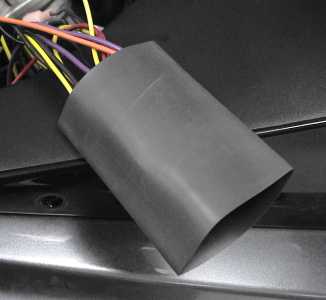
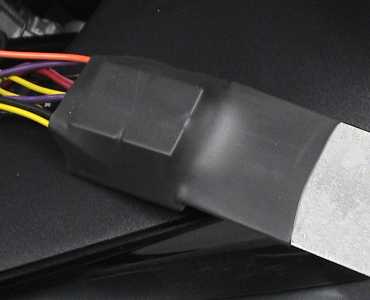
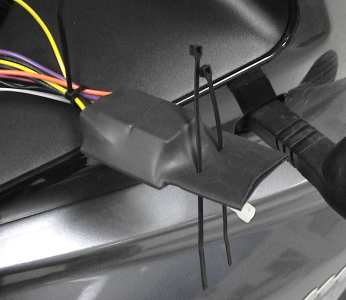
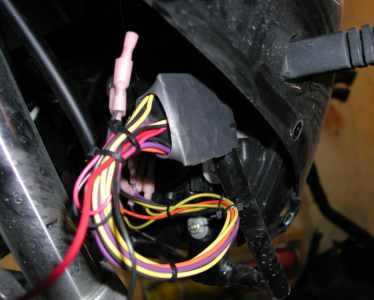
If I did it again, there are a few minor things I'd change:
That's about it, actually. STUN mode gives glorious
light for night riding. I use SQUINT mode with heated gear
on my morning commute to work, and the extra charging makes up for my
commute home (which is in the dark, usually with the heated gear on full
and liberal use of STUN).
The voltmeter is fun to watch. While starting the bike the
battery voltage dips down to about 8V. Wow!